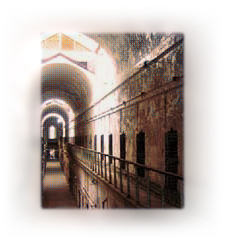|
|
 |
 |
DESTINATION GUANTANAMO BAY, CUBA
The Legitimacy of GTMO: An Eyewitness Report, Page 6
A Travel Journal by Dr. Eric A. Zillmer
Pacifico Professor of Psychology at Drexel University

< PREVIOUS SECTION | NEXT SECTION >
|
 |
 |
The Psychology of Prisons
November 10, (Mugshots, Café, Philadelphia)
1230

|
 |
“It isn’t art!” my friend John Langdon tells me over a cup of coffee.
We are sitting outside at Mugshots, a café opposite the formidable entrance to Eastern State Penitentiary discussing my upcoming exhibit on Military Psychology.
“What do you mean?” I respond defensively.
“Your exhibit on Military Psychology. It is not art,” John repeats. I am hurt, because John is referring to my exhibit that is opening up in two weeks. John is helping me design the exhibit, which I appreciate. John is a professor of advanced typography and logo and somewhat of a cult figure having created the ambigrams for Dan Brown’s novel Angels and Demons, and was the basis for the protagonist of that novel and its sequel The da Vinci Code.
 Eastern State Penitentiary’s walls, which loom over us, were designed to intimidate Philadelphia citizens so that they would not commit crimes. Built in the early 19th century, it was the largest public building at the time and represented a paradigm shift in terms of the treatment of prisoners. All had an individual room and his own small courtyard. Related to Quaker doctrine, isolation and reflection were thought to be the ideal context for rehabilitation to occur. Since then prisons have changed. Other famous prisons, like the Nuremberg Prison - site of the Trial of the Century, the Nuremberg International War Crimes trials - functioned as a holding block for high-ranking Nazis charged with crimes against humanity. Other notorious prisons, such as the Soviet Gulags, were working prisons where inmates were exploited. Concentration camps such as Auschwitz and Birkenau were death camps built far away from German scrutiny in eastern occupied territories, where the elimination of prisoners was the mission. Eastern State Penitentiary’s walls, which loom over us, were designed to intimidate Philadelphia citizens so that they would not commit crimes. Built in the early 19th century, it was the largest public building at the time and represented a paradigm shift in terms of the treatment of prisoners. All had an individual room and his own small courtyard. Related to Quaker doctrine, isolation and reflection were thought to be the ideal context for rehabilitation to occur. Since then prisons have changed. Other famous prisons, like the Nuremberg Prison - site of the Trial of the Century, the Nuremberg International War Crimes trials - functioned as a holding block for high-ranking Nazis charged with crimes against humanity. Other notorious prisons, such as the Soviet Gulags, were working prisons where inmates were exploited. Concentration camps such as Auschwitz and Birkenau were death camps built far away from German scrutiny in eastern occupied territories, where the elimination of prisoners was the mission.
But what is the mission of GTMO’s detention facilities? Obviously, it is not for the rehabilitation of its detainees. Nor is it a place where individuals are paying their sentence to society. In fact, most detainees have not been provided a trial or sentence, and some may not have been told what they are accused of. Thus, I am speculating, GTMO appears to be a sophisticated intelligence operation, as well as a detention facility where dangerous individuals are being kept and their intelligence value to the Department of Defense is assessed.
“Do you think the Rocky statue is art?” I respond. John smiles, “I did not say your Military Psychology exhibit wouldn't be interesting, just that it is not art.”
NEXT...
|
|
|